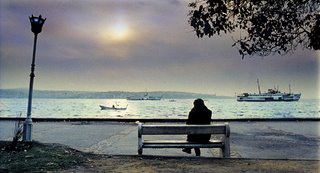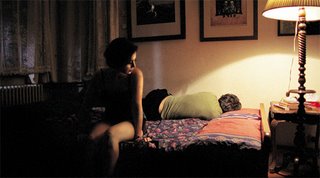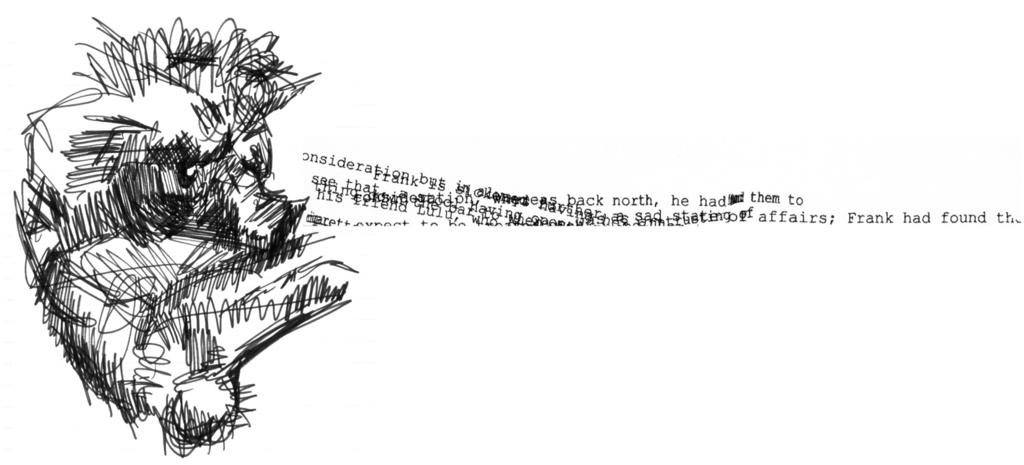 Frank’s black Impala, a ‘73 with opera windows, cruises across the surface of the moon, way out on the cold, dark side.Actually he’s skittering his monstrous auto across both lanes of Interstate 64, about eight miles out of Taos. He’s kicking up red dust and narrowly avoiding various species of cacti and the Sangre de Christos are visible to his right and the sun hangs low low on the horizon to his left and he is trying to balance Paris Spleen on his knee and wondering why there is so much unrequited love in the world when hatred is given away en masse and he must soon make the decision if he is going to continue on up to El Prado where he knew a good pemmican and whiskey joint by the name of the Dirty Sanchez, or just hooking a left south down on 25 til he got to Chihuahua where he knew a gal named Miriam in San Pablo who was often friendly and sometimes even unaccompanied. Either way, he was in for a long night…
This was one thing film (and the media at large) routinely tricked us about: Time-frame. How unbearably long were wars and tortures, really? How short were loves and lives? Few films have wanted or tried to tell. Jim Jarmusch does it a lot (watch John Lurie and Tom Waits staring at each other in a prison cell in 1986’s Down by Law). Another such film is Turkish director’s Nuri Bilge Ceylan’s 2002 feature, Uzak (Distant), now available on DVD by New Yorker Films.To the untrained eye, Ceylan’s film is simply just tedious, and not because of the subtitles which are definitely not unwieldy (or perhaps just wieldy?). The story centers on Mahmut, a commercial photographer in Istanbul pining over an ex-wife. He lives working, watching porno, and even eating by rote, until a distant relative named Yusuf moves in from the country as he looks for work, messing up Mahmut’s self-absorbed routine.
Frank’s black Impala, a ‘73 with opera windows, cruises across the surface of the moon, way out on the cold, dark side.Actually he’s skittering his monstrous auto across both lanes of Interstate 64, about eight miles out of Taos. He’s kicking up red dust and narrowly avoiding various species of cacti and the Sangre de Christos are visible to his right and the sun hangs low low on the horizon to his left and he is trying to balance Paris Spleen on his knee and wondering why there is so much unrequited love in the world when hatred is given away en masse and he must soon make the decision if he is going to continue on up to El Prado where he knew a good pemmican and whiskey joint by the name of the Dirty Sanchez, or just hooking a left south down on 25 til he got to Chihuahua where he knew a gal named Miriam in San Pablo who was often friendly and sometimes even unaccompanied. Either way, he was in for a long night…
This was one thing film (and the media at large) routinely tricked us about: Time-frame. How unbearably long were wars and tortures, really? How short were loves and lives? Few films have wanted or tried to tell. Jim Jarmusch does it a lot (watch John Lurie and Tom Waits staring at each other in a prison cell in 1986’s Down by Law). Another such film is Turkish director’s Nuri Bilge Ceylan’s 2002 feature, Uzak (Distant), now available on DVD by New Yorker Films.To the untrained eye, Ceylan’s film is simply just tedious, and not because of the subtitles which are definitely not unwieldy (or perhaps just wieldy?). The story centers on Mahmut, a commercial photographer in Istanbul pining over an ex-wife. He lives working, watching porno, and even eating by rote, until a distant relative named Yusuf moves in from the country as he looks for work, messing up Mahmut’s self-absorbed routine.

The film opens with a long long static shot of Yusuf trekking across the snow into town, and then settles in to document Mahmut’s little solitary life. Aside from an answering machine recording, there is no dialog for well over ten minutes. This is certainly not a film for those unnerved by the silent outset of Kubrick’s 2001 (1968). Note the primary colors as Yusuf arrives at Mahmut’s, yellow walls, a red bucket. This continues throughout the film and is quite striking with red, yellow and blue highlighting almost every shot and particularly breathtaking as Yusuf surveys a sunken freighter in the harbor. Often these highlights, such as distant minarets, look so placed and artificial that the American consumer assumes they are digitally created. Can a director still be in such dark ages that he is still scouting and framing each shot?! But other photographic imperfections are evident. Watch the color changes shot to shot in some scenes. And be amused at Mahmut’s exclamation about TV:
“This thing has 50 channels but there’s only shit. What a rip –off!”
(Alas, poor Turkey! Don’t worry in the USA we have 500+ channels and only shit!). And enjoy a scenic shot of Mahmut on the waterfront (also the DVD cover photo) and wonder whether the puff of smoke is from his cigarette or a chimney in the distance. Or see Mahmut in a hospital corridor and be reminded of death and afterlife. Also check out Mahmut’s silly east European wedge-car. And wonder what the hell is that thing on Yusuf’s temple (Sadly actor Mehmet Emin Toprak was killed in an auto wreck shortly after filming). But always look for the red, yellow and blue.
And on the extra features, don’t be disappointed that the film Cocoon is not the one that features Steve Guttenberg (1985).
 Uzak is a film about urban anomie and the pacing is reflective of this. Warning, its appropriate and clever, but half-way through, you’re going to be sick of it. It’s a film to see also if you want to know what the rest of the world in putting out in the cinema; at that, check out Abdykalykov’s "The Adopted Son": (Beshkempir, 1998) to see what (those crazy monkeys out in Kyrgyzstan are up to or even rent Fernando León de Aranoa‘s, "Mondays in the Sun" (Los Lunes al Sol, 2002) to see the plight of the worker in modern Europe. And at the end, try not to think of the derivativeness to Fellini’s La Strada (1954).
And Frank has decided on Mexico (and Miriam) and hops the pavement to get unto 585 West. The car drags heavily into the eastbound lanes as Frank reaches under the bench seat. If he can get to the packet of Captain’s Wafers that he is sure is there, he won’t have to pull over til that beast of a gas tank finally empties.
Uzak is a film about urban anomie and the pacing is reflective of this. Warning, its appropriate and clever, but half-way through, you’re going to be sick of it. It’s a film to see also if you want to know what the rest of the world in putting out in the cinema; at that, check out Abdykalykov’s "The Adopted Son": (Beshkempir, 1998) to see what (those crazy monkeys out in Kyrgyzstan are up to or even rent Fernando León de Aranoa‘s, "Mondays in the Sun" (Los Lunes al Sol, 2002) to see the plight of the worker in modern Europe. And at the end, try not to think of the derivativeness to Fellini’s La Strada (1954).
And Frank has decided on Mexico (and Miriam) and hops the pavement to get unto 585 West. The car drags heavily into the eastbound lanes as Frank reaches under the bench seat. If he can get to the packet of Captain’s Wafers that he is sure is there, he won’t have to pull over til that beast of a gas tank finally empties.




0 Comments:
Post a Comment
<< Home